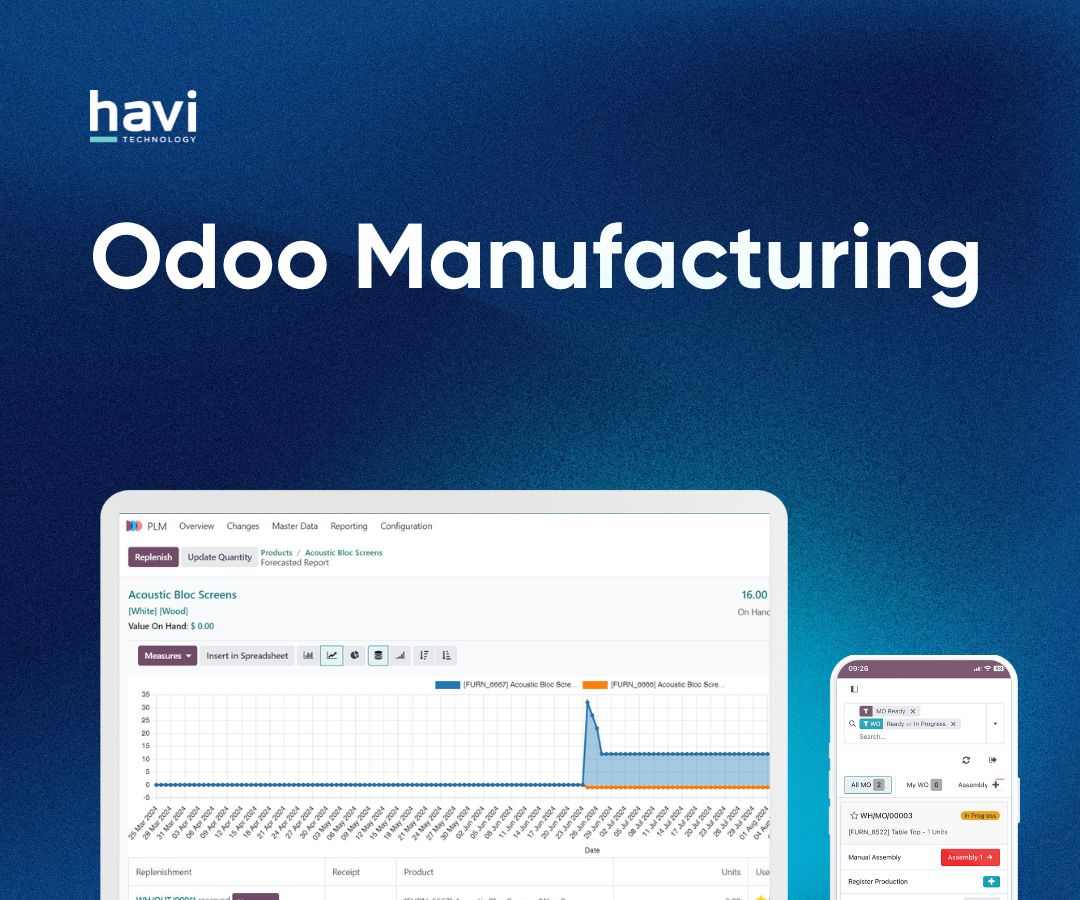TABLE OF CONTENTS
- 1. Website and Customer Experience
- 1.1. Website & eCommerce: Guided Onboarding, New Templates, Google Merchant Sync
- 1.2 Live Chat and Discuss: Expertise Routing, Chat Insights, Status Controls
- 2. Sales, CRM and Subscriptions
- 2.1 Sales: Editable Optional Products, Catalogue Sections, Portal Top-Up
- 2.2. CRM and Marketing: AI Probability, Lead Sources, Kanban Linking
- 2.3. Subscriptions: Prorated Billing, One-Time Sales, Portal Edits
- 3. Inventory, Purchase and Barcode
- 3.1. Inventory and Purchase: Packages within Packages, Forecasted Reports, Suggested Quantity to Replenish
- 3.2. Barcode: Operation Descriptions, Product Source Location, Lot and Serial Number Properties
- 4. Manufacturing, Shop Floor & Planning
- 4.1. MRP: Gantt View, Editable Deadlines, Labour-Based Valuation
- 4.2. Shop Floor & Planning: Barcode Workflows, Shift Scheduling, Routing Edits
- 5. Project, Timesheets and Services
- 5.1. Project and Timesheet: Smart Assign, Mobile Grid View, Priority Alerts
- 5.2. Field Service and Appointments: Calendar View, Technician Tracking, Mass Planning
- 6. HR, Payroll and Expenses
- 6.1. Payroll: Redesigned Engine, Payslip Correction, Unified Master Report
- 6.2. Time Off and Expenses: Odoo Master Cards, Multi-Expense Submission, Complex Duration
- 7. Accounting, Compliance and ESG
- 7.1. Accounting: Peppol Invoicing, Bank Sync, BAS Reports
- 7.2. ESG App: Scope 1–3 Emissions, CSRD Reporting, Auto Category Mapping
- 8. AI, Documents and Sign
- 8.1. AI App: Prompt Commands, Auto Field Completion, Voice and Web Search
- 8.2. Sign and Documents: Bulk Signing, Chatter Integration, Access Controls
- Odoo 19: What’s Coming For Australia?
- 1. Fully compliant Payroll AU with STP Phase 2 and SuperStream
- 2. ABA file payments, Direct Debit for wages/super
- 3. Multi-stream YTD import, backpay, and validations
- 4. 2025–26 tax rules, STSL changes, ATO security
- 5. Peppol invoicing, GST toggle, fringe benefits, BAS automation
- 6. Tyro integration
- 7. Roadmap: SBR BAS lodging, Open Banking, PEL Access, Fiduciary Program
- Odoo 19’s FAQs For Australian Teams
- 1. How should Australian businesses prepare?
- 2. How is Odoo 19 different from Odoo 18 in Australia?
- 3. How can AI in Odoo 19 be tailored for real business outcomes?
- 4. How can I try Odoo 19 or upgrade from my current version?





Manufacturing digitalisation offers an innovative approach that eliminates the use of spreadsheets.
One question: Have you or your manufacturing teams recently inspected numerous rows of data extending over a huge spreadsheet? It contains important production data, and errors are likely to be ignored. Each month, your staff fights with formulas and investigates problems for hours.
This data silo is only one indicator of a bigger issue in today's manufacturing setting - the restrictions of manual operations. However, manufacturing digitalisation enables you to access precise, effective, and real-time data.
In this reading, we will discuss how digitalisation can transform your manual procedures and why ERP solutions are the cornerstone of this revolution.
Manufacturing Digitalisation: Explanation & In-Action Examples
1. What is manufacturing digitalisation?
Rather than depending mostly on handwritten clipboards and work orders, your busy production floor is interconnected and constantly collects data from a single source of truth. Machines are installed with sensors, and production lines are linked together, enabling flexible modifications based on demand variations.
This integrated system refers to manufacturing digitalisation - the integration of digital technologies and data-driven systems into every aspect of manufacturing. To survive in the modern industry, manufacturers have to take important transformative actions.
2. Digitalisation in manufacturing examples
No.1 Implement an Enterprise Resource Planning (ERP) System
The ERP system functions as the nerve centre of a digitalised factory. It replaces disconnected data from spreadsheets and manual processes with a single source of truth. This provides real-time data visibility across every part of the business: production scheduling, inventory management, quality control, financial analysis, and more.
In the 2024 report, Panorama Consulting Group shows that after implementing an ERP, around 90% of respondents achieved productivity and efficiency. Moreover, 62.8% of them realised the benefit of optimising inventory levels.
No. 2 Employ Industrial Internet of Things (IIoT) and Sensor Integration
Industrial Internet of Things - IIoT, is defined as a network of physical devices that are equipped with sensors that collect and distribute data. These sensors on machines can track and measure performance parameters such as temperature or energy usage. This real-time information gives manufacturers predictive maintenance, minimising breakdowns while reducing downtime.
Especially, predictive maintenance gained huge recognition. It generally lowers machine downtime by 30 to 50% while extending machine life by 20 to 40% (McKinsey & Company).
No. 3 Utilising Big Data Analytics and Machine Learning
Big data analytics and machine learning are innovative tools for manufacturers to analyse data that identify trends, forecast potential problems, and enhance operations. Manufacturers may predict future demand and optimise production schedules by looking at historical data on production calendars, sales numbers, and material usage.
In the Forbes report, 68% of manufacturing executives believe that it requires analytics to drive revenue, reinforce competitive edge, and optimise operations.
5 Ways Digitalisation Rescues Your Team From Manual Work
Let's admit it: manual tasks in production are terrifying. They cause inefficiencies and limit growth with errors in data entry, poor visibility, and safety threats. Following is how digitisation takes place to address the problems and streamline your operations:
1. Automated data entry and integration
Manually entering data from production logs, quality inspections, and stock counts is time-consuming and prone to errors. Incorrect data can lead to production delays, missed deadlines, and false inventory counts.
The digitalisation solution: Real-time data on the shop floor is automatically collected by several solutions which can be sensors, machine-to-machine interaction, and barcode scanners. This minimises manual data input, and errors, and maintains data integrity throughout every single department. After automating data entry, businesses have achieved a 90% increase in accuracy and a 92% improvement in compliance (Deloitte). These statistics prove that automated actions help reduce costs and improve data integrity.
2. Real-time production monitoring and control
Traditional production control requires manual data collecting and reports. This makes it take longer to identify problems and delays proactive modifications.
The digitalisation solution: Digital dashboards in an ERP or Manufacturing Execution System (MES) and visualising tools deliver real-time data into production operations. The data on machine efficiency, stock levels, and production activity enable manufacturers to quickly adjust regarding unpredictable cases or machine performance.
For instance, you can configure an ERP system to send notifications when a machine runs behind schedule or surpasses energy usage restrictions. Production managers may thereafter assess the problem and take quick steps to fix it, reducing downtime and production delays.
3. Predictive maintenance and reduced downtime
Unexpected machinery breakdowns may result in substantial interruptions and production delays. It can become more costly and ineffective if manufacturers only rely on regular maintenance.
The digitalisation solution: Sensor data and analytics systems can forecast potential equipment breakdowns using historical data and real-time performance metrics. This lets manufacturers perform proactive and predictive maintenance, including scheduling maintenance before a failure occurs. Further, users can configure ERP systems to send alerts of work orders using sensor data to ensure timely repair solutions. Not only McKinsey & Company, but Deloitte also pointed out the advantages of predictive maintenance: a 25% increase in productivity, a 70% reduction in breakdowns and a 25% reduction in expenses.
4. Standardised workflows and improved quality control
Inconsistent manual operations and quality inspections could end up creating product flaws and discrepancies. This not only has an influence on customer satisfaction but also drains resources and escalates rework expenses.
The digitalisation solution: Digital systems like an ERP may enforce standardised practices and automate quality tests. ERP systems can be configured to include specific workflows and quality parameters. This makes sure that regular inspection processes are accurately followed and complete products successfully reach customers. Plus, automated inspection tools can detect problems with greater precision and consistency than manual inspections.
Learning From TR Savage & Sons: Reduced Scheduling From 2.5 to 1.5 Employees
One of our clients, TR Savage & Sons, is a prominent Australian manufacturer with more than 100 years of experience. Their story proves the power of digitalisation in today's dynamic market. In particular, it discusses the difficulties that many factories encounter, and how manufacturing digitalisation could significantly boost operational productivity.
1. The Challenges: Manual Processes and Scheduling Headaches
Although having been highly experienced, TR Savage & Sons relied on manual processes for production control. This approach caused the business significant difficulties:
2. The Solution: MRP System Implementation
To tackle these challenges, TR Savage & Sons collaborated with Havi Technology to implement a Material Requirements Planning (MRP) system built in Odoo - a widely used open-source ERP system. The digital approach solved the key challenges through:
3. The Results: A More Efficient and Agile Manufacturer
With complete digitalisation, TR Savage & Sons achieved considerable improvements:
Getting Started: Set the Foundation With ERP Transformation
The outcomes speak for themselves: TR Savage & Sons significantly reduced their scheduling personnel through manufacturing digitalisation. This outstanding efficiency significantly reduces costs and enables them to reallocate labour to more critical activities.
The journey of manufacturing digitalisation takes time, but the potential gains for productivity, innovation, and customer satisfaction are evident.
Are you ready to tap into the power of manufacturing digitalisation in your business? Consider taking the first step: working with certified professionals, assessing your current processes and identifying areas for improvement.
References: